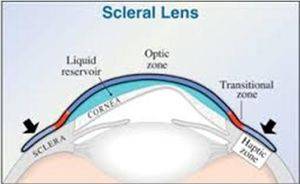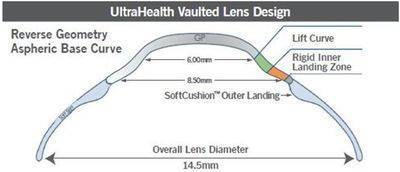Scleral (and hybrid) contact lenses: explained by Dr. Steve Jacobs
Even though it can be challenging, and I guess because of that, it’s so rewarding to fit scleral and hybrid contact lenses. It’s not something that everyone does, and it is something that takes extra time, patience, and the desire to learn new things. But to have someone say “I haven’t seen like this in years” or “for the first time in forever, I don’t feel the lenses in my eyes all the time”, it makes that effort worth it and really makes me happy I chose optometry as a career.
 The earliest contact lenses, made of hand blown glass in the 1880s, covered pretty much the whole front of the eye (the sclera). An amazing accomplishment, but not surprisingly, it didn’t work too well. By the 1930s, custom molds of the eye could be made from plastic. They also covered a large area, and the molding process was not what most people would consider fun. Add to this the fact that no oxygen could get through, making things blurry within an hour, and it’s easy to see why scleral lenses never became the “next big thing”.
The earliest contact lenses, made of hand blown glass in the 1880s, covered pretty much the whole front of the eye (the sclera). An amazing accomplishment, but not surprisingly, it didn’t work too well. By the 1930s, custom molds of the eye could be made from plastic. They also covered a large area, and the molding process was not what most people would consider fun. Add to this the fact that no oxygen could get through, making things blurry within an hour, and it’s easy to see why scleral lenses never became the “next big thing”.Fast forward to today, and as they say, “everything old is new again”. Take the best points of an older idea and marry them to modern technology and understanding, and you get an innovative product that does things other products can’t. A rigid contact lens ‘corrects’ an eye’s natural irregularity by in effect becoming the new surface. Today’s materials possess wonderful optical qualities and are highly oxygen permeable, while precision computerized manufacturing allows the production of comfortable, customized lenses based on individual measurements.
Conditions such as keratoconus (very irregular shape to the front of the eye), eye trauma or corneal surgery, may lead to distortion and significant visual impairment even with glasses. Soft lenses take on the eye’s shape and so don’t do much about irregularity. Smaller, rigid, corneal lenses may rub against the irregular area, not stay in position, or be uncomfortable to wear for extended periods. Scleral lenses, on the other hand, vault over the irregularity. Fluid fills the gap between the front of the eye and the contact lens, allowing the lens to become the “new” front surface and provide more normal vision. Since it fits on a less sensitive part of the eye, comfort is usually quite good.
Even with normal corneas, scleral lenses, due to their superior optics, can provide the sharpest vision, and since the eye is constantly bathed in fluid they may handle dry eye symptoms better than other options.
 Another specialty lens, a Hybrid, has a rigid center allowing correction of many irregularities, with a soft outer portion providing better stability, and comfort closer to that of a soft lens. Which can work best, a scleral or a hybrid, depends on the specific case and the specific individual, but it’s great to have them both as possibilities.
Another specialty lens, a Hybrid, has a rigid center allowing correction of many irregularities, with a soft outer portion providing better stability, and comfort closer to that of a soft lens. Which can work best, a scleral or a hybrid, depends on the specific case and the specific individual, but it’s great to have them both as possibilities. We also carry a variety of colored contact lenses!
